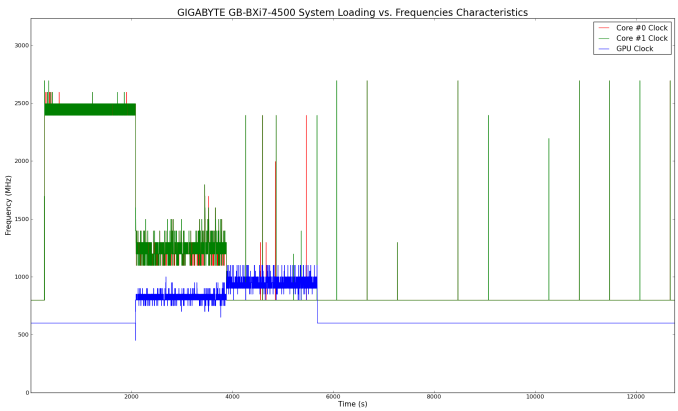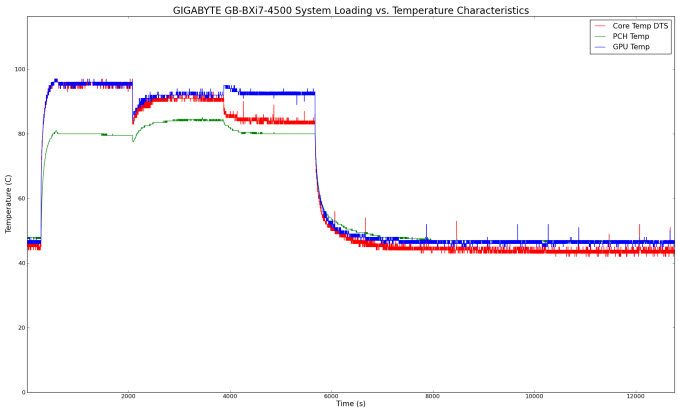GIGABYTE BRIX GB-BXi7-4500 Review: Intel Core i7 in a UCFF PC
by Ganesh T S on October 9, 2014 7:00 AM ESTPower Consumption & Thermal Performance
The power consumption at the wall was measured with a 1080p display being driven through the HDMI port. In the graphs below, we compare the idle and load power of the GIGABYTE GB-BXi7-4500 with other low power PCs evaluated before. For load power consumption, we ran Furmark 1.12.0 and Prime95 v27.9 together. The numbers are not beyond the realm of reason for the combination of hardware components in the machine.


As expected, the BXi7-4500 consumes more power at idle as well as load compared to the slightly less powerful i5-based Haswell NUCs. The ZBOX OI520 Plus ends up with a higher idle power consumption because of the hard drive inside the unit, but, otherwise, the ordering of various PCs in the above two graphs is as expected.
The evaluation of the thermal performance was performed by monitoring the various clocks in the system as well as the temperatures with the unit when subject to the following workload. We start with the system at idle, followed by 30 minutes of pure CPU loading. This is followed by another 30 minutes of both CPU and GPU being loaded simultaneously. After this, the CPU load was removed, allowing the GPU to be loaded alone for another 30 minutes.
The advertised frequencies are 1.8 GHz (to 3.0 GHz) for the CPU and 200 MHz (to 1.1 GHz) for the GPU. Under pure CPU loading conditions, the cores operate at 2.4 GHz while still managing to prevent thermal throttling. The GPU 'idles' at 600 MHz. Simultaneously loading up the CPU and the GPU pulls down the core clocks to around 1.2 GHz, with the GPU around 800 MHz. Loading only the GPU pulls up the GPU clocks to around 900 MHz with the occassioanl burst to 1.1 GHz. As the temperature graph below shows, DTS never plummets to 0, indicating that the system doesn't suffer from thermal throttling.Idlling temperatures are reached with 15 - 20 minutes of load removal, thanks to the fan inside the unit. The junction temperature of the i7-4500U is 100 C, and the fan manages to keep the temperature around 96 C under heavy loading conditions.












27 Comments
View All Comments
dakishimesan - Thursday, October 9, 2014 - link
One other thing – even though the Mac Mini is 7.5 in.² as opposed to the 4.5 in.² of this computer, the Mac Mini has an integrated power supply.Samus - Friday, October 10, 2014 - link
I do agree the mobile i7 is a waste of money. It always has been. It's super shady how Intel promotes their ultramobile i5 and i7; they're nothing like their desktop equivalent.It's funny that Baytrail is the only true quad-core (physical) ultramobile CPU Intel has.
dakishimesan - Thursday, October 9, 2014 - link
Over the last couple of years, the ultra-compact form factor (UCFF) has emerged as one of the bright spots in the troubled PC marker.dgingeri - Thursday, October 9, 2014 - link
Most importantly: can it run WoW and STO at a decent framerate?Wilco1 - Thursday, October 9, 2014 - link
So how is it possible for a CPU with a claimed 15W TDP to use 30W extra from idle to full load???MrCommunistGen - Thursday, October 9, 2014 - link
I assume there are a number of factors involved. In no particular order:1. Power measurements are at the wall so we're accounting for PSU efficiency as well
2. With Intel's Turbo, as long as the thermals aren't out of control, the CPU can exceed its TDP
3. The CPU isn't the only component that can draw more power when the system is under heavy load. The obvious component that comes to mind is the system fan. In a system with power consumption this low, fan power draw becomes relevant.
MrCommunistGen - Thursday, October 9, 2014 - link
I meant to explicitly state that I did not intend for my 3 bullet points to be taken as an exhaustive list...Mentally ballparking the numbers, these factors seemed to add up well enough to account for the extra 15W over TDP. My thought process basically stopped there.
Wilco1 - Thursday, October 9, 2014 - link
You're right there are other aspects besides the CPU but eg. the D542050WYKH also has a CPU with a claimed 15W TDP and it also has a fan, memory, turbo, power supply inefficiencies etc, and yet it manages to use 10W less. So how do you explain the difference?mmaenpaa - Thursday, October 9, 2014 - link
It would be nice to see review of GB-BXA8-5545 with the same components. I believe the barebones version (no memory & no SSD) is about 250$.http://www.gigabyte.com/products/product-page.aspx...
Markku
bleomycin - Thursday, October 9, 2014 - link
Maybe I missed it but there was no mention of fan noise or bios fan control options? I have a 2nd generation i5 brix and would never buy one again due to the non-existent bios fan controls. I have to use speedfan under windows or fancontrol under linux to keep this thing within reasonable audible limits just for running xbmc. My nuc systems handle all of that just fine in the bios.